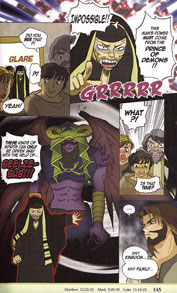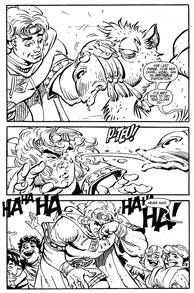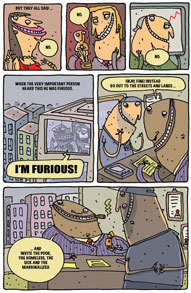
Superman #132 was the gateway drug that got me into comics. Little did I know when I purchased that comic at a railway station newsagency it would lead to an addictive love affair. That first comic in my possession was by no means the greatest comic ever written but it inspired me to know more. To buy more. These days I’m a committed comic fan, as the wall of comics in my house will attest.
Every collector has that much sought-after prize. That rare and elusive item that consumes the collector. For me, that prize is the Christian comic book.
It’s not that Christian comic books don’t exist. The number of Christian comic books available for sale appears to be growing each day. The problem with these comics is that I have two criteria that must be met. Firstly, they must be good. Substandard art and storytelling won’t make the cut. Secondly, they must be in line with God’s word and not contradict or distort the Bible. Sadly, many Christian comic books fail one or both of these criteria.
Christian comic books fall into two categories: comics that retell Bible stories and comics that tell stories with a Christian theme or message.
Comics retelling Bible stories are popular for obvious reasons. We recognise the Bible is important and we want people to read it. However, which Bible stories are chosen for adaptation into comic book form can be frustrating. The focus of the Christian faith is the person of Jesus and his fulfilling of God’s plan of salvation. So naturally the four gospels have prominence in our church teaching and reading. If the world of Christian comics was our guide, then the most important person in the Bible is King David. Followed closely by Samson. Then Jesus. Seems to me that there is something wrong here.
The problem is that comics are a visually dynamic medium. Jesus never killed a giant with a rock or tore a lion apart with his bare hands. So he’s not going to be as popular with comics trying to prove to young boys that the Bible is exciting.
 It’s not that comics about David can’t be good. David: The Shepherd’s Song has some really impressive art, using a loose line style that really pops on the page and conveys action scenes (see the example above) really well. So far, I’ve only got my hands on the first part of this book but am looking forward to reading the rest. What will make or break this book for me is how the author will deal with 2 Samuel 7 (David’s desire to build a temple for God and God’s promise to establish David’s line forever). Too often these comics isolate the stories of Old Testament figures from the big story of the Bible. They turn these men into action figures that have no relation to God’s plan of salvation. I have high hopes for the rest of the David: The Shepherd’s Song series.
It’s not that comics about David can’t be good. David: The Shepherd’s Song has some really impressive art, using a loose line style that really pops on the page and conveys action scenes (see the example above) really well. So far, I’ve only got my hands on the first part of this book but am looking forward to reading the rest. What will make or break this book for me is how the author will deal with 2 Samuel 7 (David’s desire to build a temple for God and God’s promise to establish David’s line forever). Too often these comics isolate the stories of Old Testament figures from the big story of the Bible. They turn these men into action figures that have no relation to God’s plan of salvation. I have high hopes for the rest of the David: The Shepherd’s Song series.
On the other hand, you have books like Son of Samson. This series stars a young man called Branan, who is allegedly the son of Samson. Branan travels across Israel and learns all about his father’s exploits. The artwork in this book is engaging and grabs your attention but something doesn’t sit right, probably because Branan (the good guy) is depicted as being, for all intents and purposes, Anglo-Saxon. And the bad guys? Middle-Eastern caricatures. I find this kind of subtle racism in a comic disturbing — but not as disturbing as the telling of Samson’s life. We have are all the highlights — destroying the Philistine temple, killing the thousand with the jawbone of a donkey — but none of the lowlights. All context has been stripped out of these accounts. Samson becomes a mythological Superman who never did anything wrong and never acted in a way that was selfish and ungodly. And there’s no suggestion that he was an imperfect saviour who achieved more in death than he did in life. Instead we have a Saturday morning cartoon that I would struggle to call Christian.
When it comes to comics about Jesus, Manga Messiah has been a popular choice in recent years. This Japanese style of storytelling has spawned several ‘sequels’, covering books such as Genesis and Acts. Manga Messiah takes a harmony approach to telling the story of Jesus, drawing on all four gospels, beginning with the angel Gabriel appearing to Mary and finishing with Jesus’ ascension. The art style is expressive and makes great use of colour. The text sticks pretty close to the biblical account and also includes footnotes on every page to point to the Bible passages used, which is really helpful. One area of caution with this book is the art. Because of the Japanese influence of the art, some of the visuals take on a certain look. An example of this is in Manga Mutiny where the serpent in the Garden of Eden is portrayed as a scaly humanoid with a snake’s tail, wings and feminine features. Sometimes making a visual representation of something from the Bible can give it meaning and substance that perhaps weren’t there in the first place. This is something to be cautious about with all visual retellings of the Bible.
The Christian comic that I have been most impressed with is called Parable. Harnessing the talents of a number of creators, this anthology is based around the idea of parables. Some of these stories are retellings of specific biblical parables. Others take Christian ideas and concepts and use them to create compelling stories. There’s a variety of art styles featured here, providing something for everyone. Most importantly, by trying to be Christian rather than sticking to a particular biblical text, the creators do a much better job of presenting a work that is both entertaining and consistent with God’s word. I can’t recommend this title highly enough.
These books are not even the tip of the iceberg of Christian comics. As I write this, there is a large pile of comics by my desk. Some I have read and I love. Some I have read and am embarrassed by. There are some made by Christians for Christians. There are others that are made for the secular world that explore Christian themes. There are even more in my pile that I am yet to read.
 Here are some questions to help you evaluate if a Christian comic is worth promoting:
Here are some questions to help you evaluate if a Christian comic is worth promoting:
Is the comic consistent with the Bible?
Does the comic communicate how the story fits into God’s big picture of salvation?
Does the comic engage the reader with interesting visuals and clear storytelling?
If the answer is yes to these three questions, then chances are you have a good Christian comic in your hands.
















